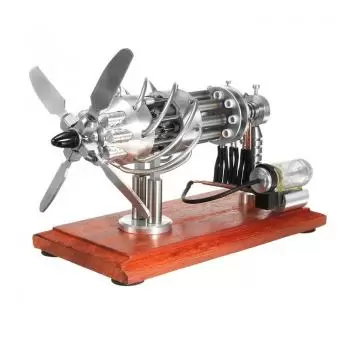
The Stirling engine's journey through history begins in the early 19th century in England. During the First Industrial Revolution, hot air engines competed with the steam engine to supply mechanical power to industrial machinery in factories and mines.
Although the steam engine offered better performance in terms of power and efficiency, the hot air engine had the advantage of being safer. In the first decades of the 19th century, steam engine boilers suffered devastating explosions due to the low quality of the materials available at the time and the technological limitations in their design and construction.
This problem initially favoured the commercial success of the Stirling engine, as it offered a safer and more reliable alternative. However, as steam engine technology improved and the risk of explosions was reduced, interest in the Stirling engine waned considerably.
Revival of the Stirling engine in the 20th century
With the advancement of electronics and the development of new devices, the Stirling engine enjoyed a revival in the 1950s. The Dutch company Philips, which specialized in the manufacture of radios, developed the Philips MP1002CA, also known as the "Bungalow Set". This small-sized electric generator was based on a Stirling unit that used oil as fuel.
The Philips MP1002CA was designed to power radio transmitters and receivers located in remote areas where there was no access to conventional power grids. With an output of approximately 200 watts, the generator integrated cutting-edge technology, including the use of lightweight alloys, allowing for a balance between efficiency, practicality and cost.
Philips continued to experiment with Stirling engines into the first half of the 1970s. In January 1971, the company even developed a prototype bus equipped with a 200-horsepower Stirling engine. However, the technology failed to establish itself in mass commercial applications, as batteries began to offer a more compact and efficient alternative for generating electrical power.
Current and future applications
Despite its decline in the second half of the 20th century, the Stirling engine has found niche applications. Stirling engines of different sizes are currently being developed, achieving significant technical advances and, in some cases, viable commercial applications.
One of the most promising uses is its integration into renewable energy systems. In particular, the Stirling engine has been used as an electrical generator in concentrated solar power plants, where a field of mirrors is used to concentrate sunlight and generate heat. This approach allows for efficient conversion of thermal energy into electricity without polluting emissions.
Another emerging application is the use of Stirling engines in domestic cogeneration systems, where waste heat is used for heating and hot water, improving energy efficiency in the home. In addition, some space agencies have explored the use of Stirling engines in radioisotope generators for long-duration space missions, due to their reliability and efficiency in extreme environments.
Although the Stirling engine has not succeeded in replacing other technologies in the mass market, its efficiency and versatility make it a viable solution in certain applications where safety, low noise and the ability to operate with various heat sources are key factors.